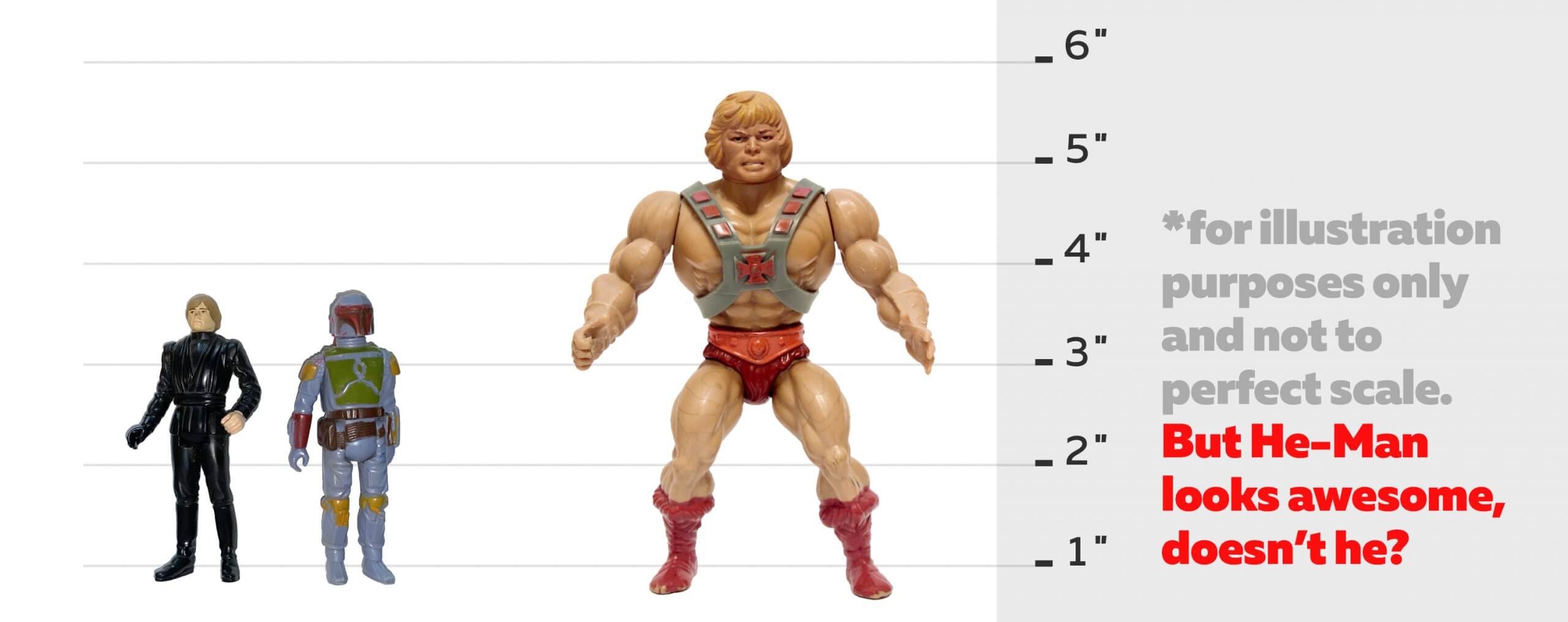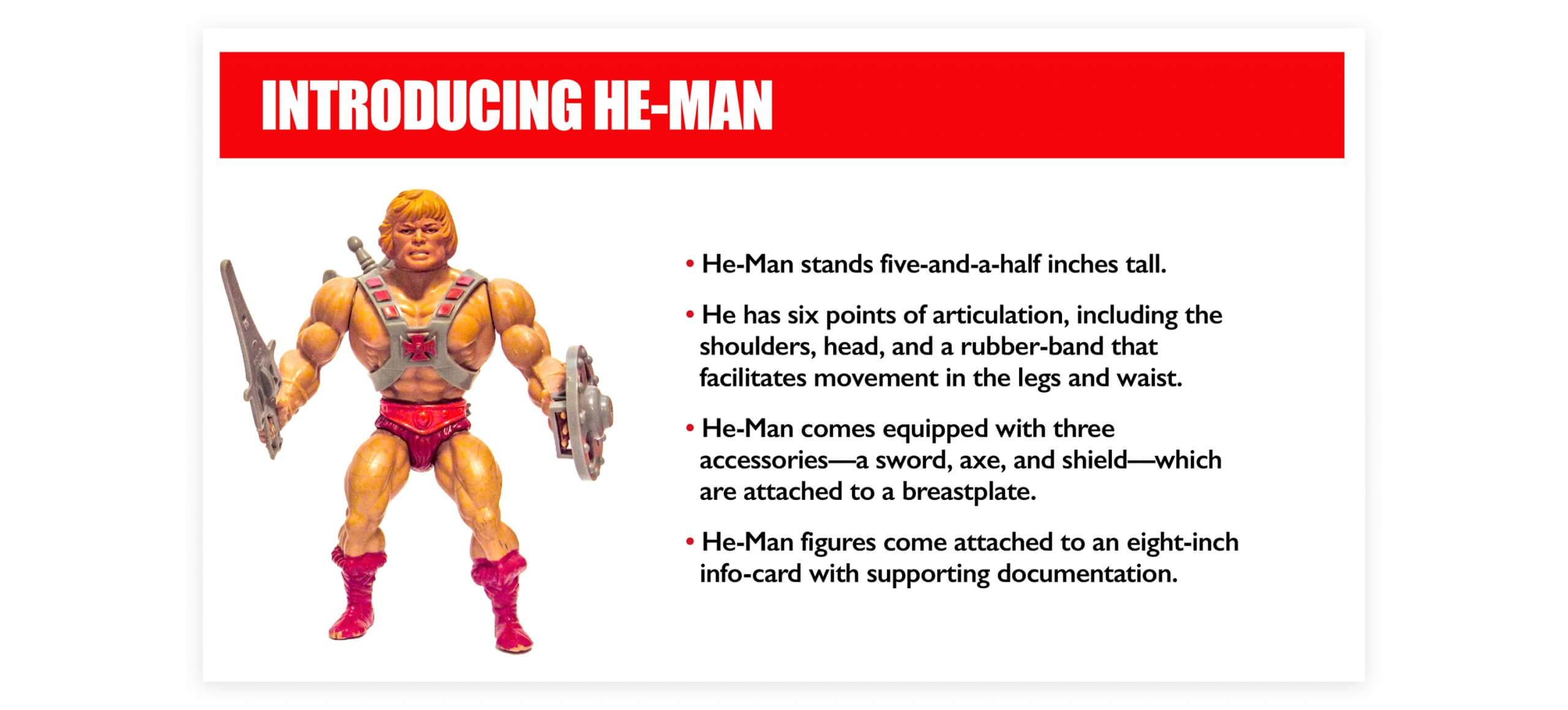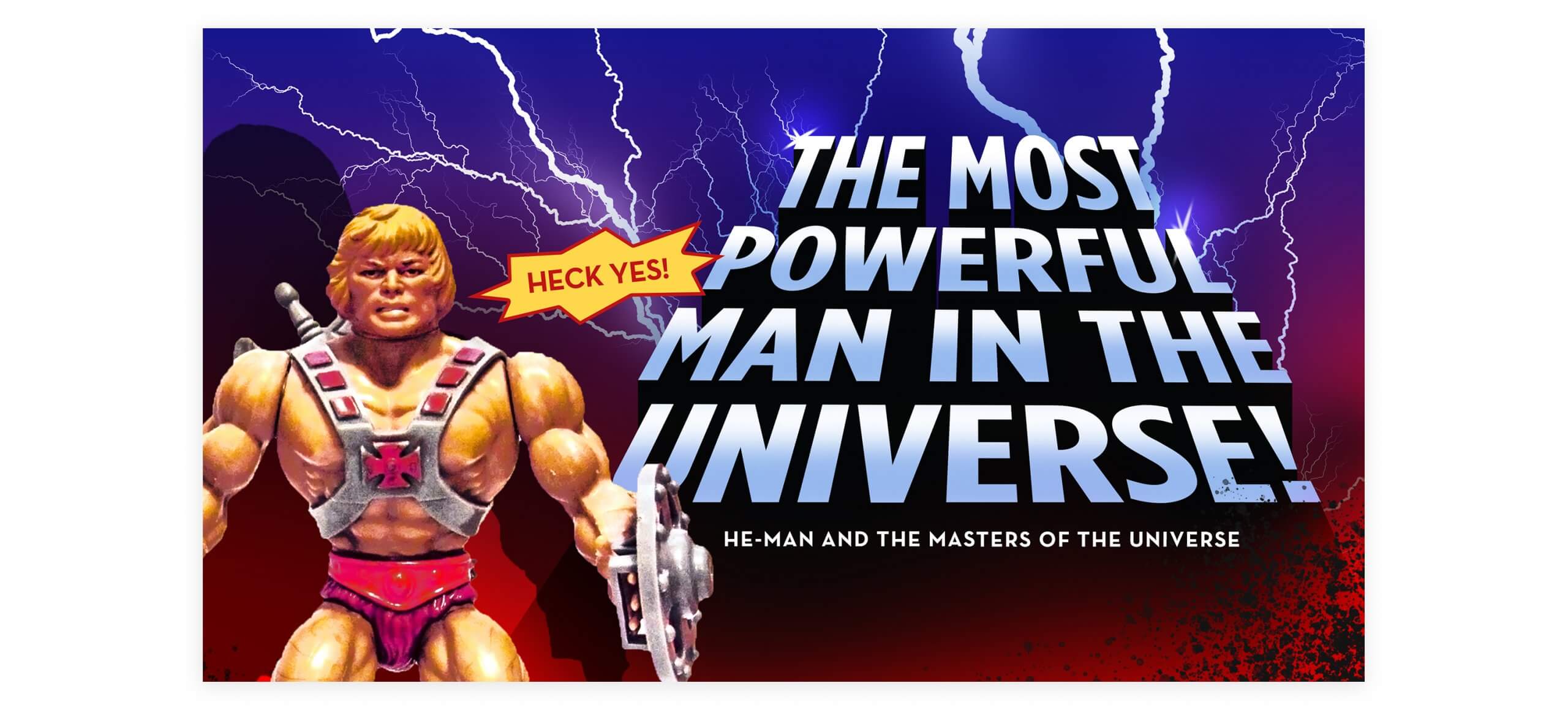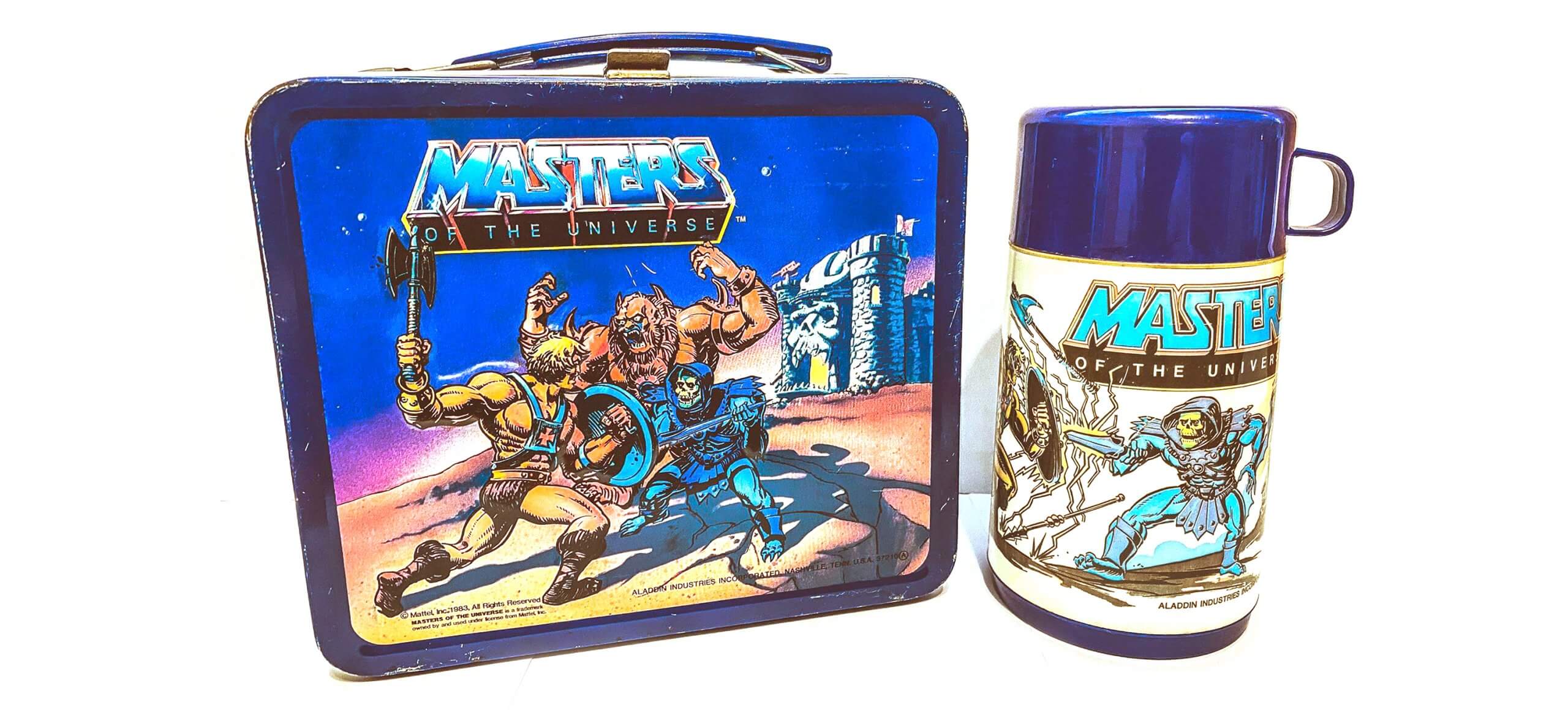



Here are five things Mattel did right and how we can apply them to our own marketing.
The Big Idea
According to self-described He-Man inventor and former Mattel designer Roger Sweet, the pitch that got He-Man made was simple. Sweet knew that if he gave marketing something they could easily sell, he would jump ahead of the crowd. He chronicled this in his 2005 book, Mastering the Universe: He-Man and the Rise and Fall of a Billion-Dollar Idea. “I simply explained,” said Sweet, “that this was a powerful figure that could be taken anywhere and dropped into any context because he had a generic name: He-Man!”
The big idea that sold Mattel on the idea of investing millions into creating the He-Man lineup was dead-simple.
When the human brain encounters something new, it cannot easily retain a list of features or facts. Simple categorization at first impression is key. The best you can hope for is your audience to walk away with one big idea for your product; “they are an X for a Y.”
The more descriptive you are while remaining less-specific, the more room you will have to go when you need to go into deeper explanations later, but you won’t turn off your audience before you get there.
For a tech product, reconsider introducing yourself as an “end-to-end encryption solution for small business emails with Brownian motion-based hybrid symbol substitution and symbol interleaving for encryption keys.” Instead, you provide “business communications with physics-based encryption.
Bigger, Badder, Buffer
Before He-Man toys were introduced, the industry-standard action figure was three-and-a-half inches tall, with Star Wars and G.I. Joe representing the best examples. The toys typically stood straight at attention in stiff poses.
When designer Sweet first envisioned He-Man, he took an existing Mattel action figure in the larger six-inch range and added massive clay muscles. Eventually, he developed the prototypical He-Man model—barrel-chested, knees bent in a horse stance, arms akimbo—that became the signature for most He-Man figures.

Toys with this new “action” stance stood up on their own and were more rugged to play with. Again, Sweet followed through on his simple introduction with a product that was simply better.
Compare He-Man to the figures that came before it and he most definitely stands out. Following the success of He-Man, more toys followed suit and five-and-a-half inches became the new industry standard. The Teenage Mutant Ninja Turtles line that followed in 1990 definitely took a lesson from Sweet’s product design, and soon dominated the marketplace– eventually displacing He-Man.
For your product, find opportunities to look and sound different than your competitors. If you can describe your product but substitute your brand name with one of theirs and the description is even 80% accurate, you stand the chance of being seen as an “also-ran.” Change your description until your product is the only one that works.
Differentiation should also be rooted in your big idea. Find whatever makes you different and expand on that. And be prepared to explain and defend it as a conscious decision.
The He-Man bible
While the toys were a hit from the start, there was no context for the characters. According to screenwriter Michael Halperin, Mattel “would get phone calls and letters from parents of kids who had purchased the toys. And they didn’t know who were the good guys and who were the bad guys.” In fact, they made an attempt to include a comic book with the early figures, but the origin stories were confusing and they did not align with one another. There was no cohesion of context.
This is why Mattel engaged animation studio Filmation to create the first-ever toy to show tie-in. The first thing Mattel did in preparation to develop the Masters of the Universe series was to develop a series bible. This document lays the foundation for every storyline and character in the universe. It outlines the history, locations, characters, and themes of the series—providing a clear reference as “He-Man fights a never-ending war to wipe out evil from Eternia and ensure that goodness, purity, and virtue reign supreme throughout the universe!” No story was produced that wasn’t checked against the bible.
Consider the series bible equivalent in your organization to be your brand bible. I know branding is often the last thing on the minds of technical entrepreneurs. However, without a clear (and widely-adopted) brand document, your sales and product teams may not be on the same page. Worse yet, the market will have no clear context into which to place your product because they will receive a different story depending on the individual delivering the message.
Invest in a good branding and marketing partner to help you tell your story and get your entire team on board. Make your brand your bible; it holds a company together and gives it personality.
You have the power!
Any good product marketer knows the mantra “people don’t buy features, they buy solutions to problems.” But even the best entrepreneurs sometimes fail to do this.
Imagine how most tech companies today might introduce a product like He-Man—with a PowerPoint slide:

“Wow,” I can hear you exclaiming. “Shut up and take my money!” … Not.
This is not the sales presentation that made so many of my peers and I drool into our bowls of Trix and Lucky Charms (or Raisin Bran in my case … thanks mom) on Saturday mornings.
Instead, here is how eight-year-old me saw He-Man:

They showed kids and their parents (usually a dad) playing with the characters in a living room. Invariably, the “storyline” involved the dad playing the “bad guy” with the kids playing the “good guy” characters—using their rubber-band-powered punch action or other gimmicks to knock over the bad guys and “win” the conflict.
The message was clear, “He-Man characters let you be the hero.” That sort of sales pitch was (and still is) undeniable, to an eight-year-old or a C-suite executive.
No executive is looking at the mountains of problems and work they have and longing for another piece of technology. They are looking to be delivered from headaches and heartaches they face every day. More than that, however, they want to be the hero.
Putting your consumers front and center in your story as the potential hero is a surefire way to get their attention. An excellent book on this topic is Building a StoryBrand by Donald Miller, which provides a model for building this approach in your marketing.
Your marketing is not about you or your product. It’s about them and what they can be through you or your product.
Cartoons, lunchboxes, and movies, oh my!
When the Masters of the Universe figures were first launched, before the television series, they were met with marginal success; enough that they realized they had something different that the market would buy. The challenge was to boost its signal to rise above the noise of G.I. Joe and Star Wars.
The obvious tactic was to launch a television series. At the same time, Mattel abandoned their in-packaging comic books and partnered with DC Comics to insert mini-He-Man-comics in their existing titles. After all, why market to those who have already purchased your product?
Mattel also made every effort to get their brand exposed to as many passive eyes as possible—not all of whom were looking to buy an action figure at that moment, but might later. This took the form of brand placement on lunchboxes, bedsheets, View-Master reels (sort of like a 1980’s Oculus Rift), notebooks, stickers, Shrinky Dinks (Google those), coin banks, and lots and lots of other merchandise.

Eventually, they made a live-action movie with Dolph Lundgren. (But we no longer speak about that. Not every channel was ready for He-Man, apparently.)
We call what Mattel did “Content Marketing.” The purpose is not to sell a product directly, but to elevate a brand’s status in the marketplace. We do this through thought-leadership writing on blogs or in print media, engaging with the market through social media and other public campaigns, or through the production of content that adds value to the audience experience.
Content Marketing keeps a brand “top of mind” and needs to be done through many different channels. This multi-channel, high-touch approach ensures that when a prospect is ready to seek a solution, yours is the one they turn to.
In conclusion: Knowing is half the battle
(Okay, so that’s G.I. Joe, but go with me on this.)
Every He-Man episode ended with a moral, so this article should follow suit.
Today’s consumer has about the same attention span of a 1980s eight-year-old, and that’s not necessarily a bad thing, but we need to market to them accordingly.
How you marketing your product is critical, and it certainly isn’t child’s play. But it should be compelling and fun.
At ADG, we specialize in stripping down complex and technical stories down to their bare essence to make them engaging and more consumable for your audience.
Why not schedule a free 15-minute chat about your marketing goals and let’s see if we can turn on the power!
He-Man product photography courtesy of Sean Latham